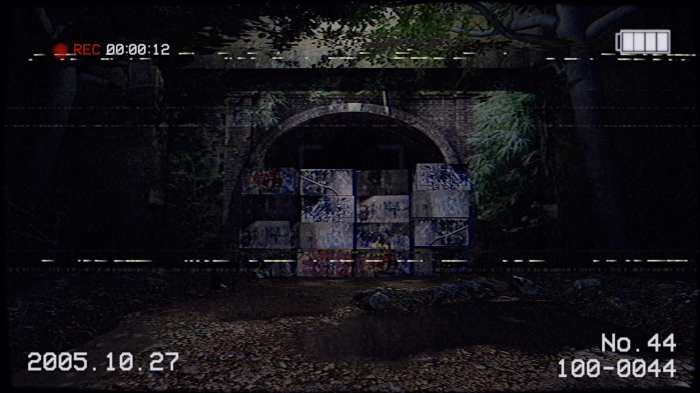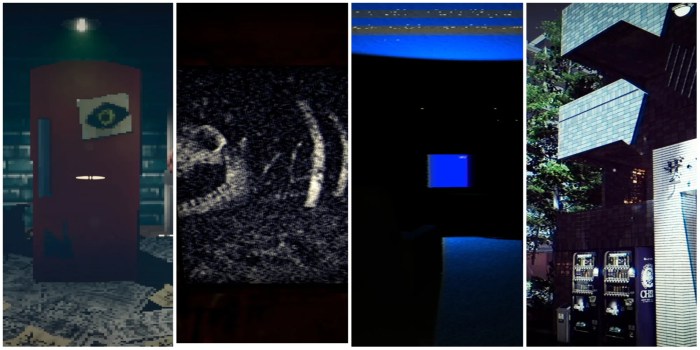Analog horror game immersive storytelling techniques unlocks a world of chilling narratives, where physicality and limited resources intertwine to craft a truly immersive experience. This exploration delves into the unique characteristics of analog horror games, contrasting them with their digital counterparts, and highlighting the crucial role of physical components in crafting a compelling story.
From the careful manipulation of physical objects to the deliberate design of sound environments, this analysis examines the strategies employed in analog horror games to amplify player engagement and evoke a sense of dread. We will delve into the intricate relationship between narrative, physicality, and player interaction within this unique genre, offering a detailed examination of the mechanics behind creating a genuinely immersive horror experience.
Defining Analog Horror Game Immersion

Analog horror games, a genre often overlooked in the digital age, offer a unique and deeply immersive experience rooted in the tangible. They leverage physical components and interactive storytelling to create a sense of dread and unease that transcends the screen, captivating players on a visceral level. This immersion is built on the interplay of physical objects, meticulously crafted narratives, and the inherent unpredictability of real-world interactions.
Analog horror games distinguish themselves from their digital counterparts through the tangible presence of physical elements. This tactile experience, coupled with the limitations of physical materials and the unpredictable nature of real-world mechanics, creates a sense of unease and anxiety that digital horror games, despite their advanced graphics and sound design, often struggle to replicate. The experience is less about the visual and more about the palpable, the tangible.
Analog Horror: A Tangible Experience
Analog horror games rely on physical components to establish a sense of realism and immediacy. These elements range from meticulously crafted environments and props to tactile materials like textured paper or unsettling soundscapes. The very act of manipulating these objects becomes a crucial part of the narrative, amplifying the sense of presence and contributing to the unsettling atmosphere. This tactile engagement creates a deeper connection between the player and the game world, fostering a heightened sense of unease. The unpredictable nature of the physical components further elevates the experience, as the environment itself becomes an active participant in the unfolding narrative.
Core Differences Between Analog and Digital Horror
Analog horror games prioritize tactile and sensory immersion over visual spectacle. The lack of instantaneous feedback often found in digital games creates a sense of vulnerability and uncertainty. Digital horror, while capable of achieving high levels of atmospheric tension, often relies heavily on pre-determined outcomes and visual cues. The physical nature of analog games, with its inherent unpredictability, makes the horror more palpable and visceral. The tangible components become integral parts of the story, forcing the player to interact with and navigate a world that exists outside the screen.
Elements Contributing to Immersion
- Physical Environments: The carefully constructed physical spaces, often incorporating props, objects, and soundscapes, create a palpable sense of dread. The very act of navigating these environments becomes an integral part of the narrative, shaping the player’s experience and amplifying the unsettling atmosphere. For example, a creaking floorboard in a dimly lit room, or the subtle rustle of paper in a dusty attic, can contribute significantly to the sense of unease.
- Interactive Storytelling: Analog horror games often employ branching narratives and interactive elements, allowing players to influence the story through their actions. This dynamic storytelling fosters a sense of agency and shared responsibility in the unfolding events, further immersing the player in the game world.
- Unpredictability and Chance: The physical nature of analog games introduces an element of unpredictability. The creak of a door, the fall of a piece of paper, or the unexpected sound of a creaking floorboard can significantly alter the player’s experience and amplify the sense of dread.
Examples of Analog Horror Games
While specific commercially available “analog horror games” are less common, examples of games incorporating horror elements through physical mediums can be found in independent projects, tabletop role-playing games, or even home-built experiences. These games leverage physical objects and components to build a sense of realism and unpredictability. For instance, a game utilizing a series of physically linked cards that reveal the progression of a nightmarish tale or a room filled with unsettling props that interact with the player in a particular way can be seen as a form of analog horror.
Comparison Table: Analog vs. Digital Horror
| Feature | Analog Horror Games | Digital Horror Games |
|---|---|---|
| Physical Components | Crucial for immersion, tactile experience, and unpredictable outcomes. | Limited to visual and auditory elements, outcomes are often predetermined. |
| Storytelling | Interactive and branching, player actions shape the narrative. | Often linear, with predetermined narrative paths. |
| Immersion | Visceral and tangible, with a focus on atmosphere and sensory engagement. | Relies on visuals, sound, and narrative, often creating a sense of disconnection. |
| Player Agency | High degree of player agency, actions have tangible effects. | Limited player agency, with outcomes primarily influenced by the game design. |
| Replayability | High replayability due to the unpredictable nature of physical interactions. | Lower replayability, with predetermined outcomes and a lack of significant variation. |
Immersive Storytelling Techniques in Analog Horror
Analog horror games, grounded in the tangible and the physical, offer a unique approach to immersive storytelling. They transcend the limitations of digital displays, relying instead on the evocative power of objects, environments, and player interaction to craft a truly visceral experience. The tactile nature of these games, coupled with their narrative structure, allows for a profound connection between the player and the unsettling world they inhabit.
The narrative in analog horror games isn’t merely a collection of words; it’s an intricate tapestry woven from physical components. Limited resources dictate the narrative structure, forcing creators to be inventive and resourceful in their storytelling. This constraint, rather than being a limitation, often fuels a more compelling and unique narrative experience. Players are drawn into a story not just by what they read or see, but by what they feel and discover through physical interaction.
The Role of Narrative in Analog Horror Games
The narrative in analog horror games isn’t confined to written text or spoken dialogue. Instead, it’s woven into the very fabric of the game, emerging from the physical environment, objects, and the player’s actions. The narrative unfolds through clues, puzzles, and the unsettling atmosphere created by the game’s components. This narrative approach emphasizes atmosphere and suspense over explicit exposition.
How Limited Resources Affect Narrative Structure
The scarcity of physical components in analog horror games directly influences the narrative structure. Limited space dictates the scope of the environment and story. Scarcity of objects and materials necessitates clever use of implication, suggestion, and the creation of suspense through the absence of information. The players must piece together clues from the limited resources to uncover the story, a process that mirrors the experience of investigation in real life. For example, a single, weathered journal entry might hold the key to a larger narrative, hinting at the secrets of a haunted house.
Examples of Physical Objects and Environments Enhancing Storytelling
Physical objects and environments are central to analog horror games’ narrative power. A rusted, decaying key, discovered amidst cobwebs in a dusty attic, evokes a sense of decay and foreboding. A flickering candle in a dimly lit room creates an atmosphere of dread and mystery. The feel of cold, damp stone against the player’s skin amplifies the sense of isolation and dread. These elements, working in concert, build a more tangible and emotionally impactful narrative experience.
Unique Narrative Possibilities Offered by Analog Horror Games
Analog horror games offer unique narrative possibilities, stemming from their inherent physicality. The tactile nature of objects and environments allows for a more immersive and visceral experience, going beyond the visual and auditory to engage the player’s senses. These games create an intimate connection with the story, unlike their digital counterparts. For instance, the smell of aged paper and ink, emanating from a hidden diary, can be a crucial part of the narrative experience, linking the player directly to the events of the past.
Methods for Incorporating Physical Narrative Elements
| Narrative Element | Method of Incorporation | Example |
|---|---|---|
| Atmosphere | Use of lighting, sound effects, and tactile materials | Dimly lit rooms with flickering candles, cold, damp stone surfaces, the rustle of leaves |
| Clues | Hidden objects, coded messages, fragmented narratives | A torn photograph, a cryptic note, a series of symbols carved into a wooden chest |
| Puzzles | Physical objects and environments | A lock requiring a specific combination of tokens, a series of objects needing to be placed in a certain order |
| Character Development | Physical representations of characters and their actions | A tattered doll with missing eyes, a collection of worn-out letters, a character’s shadow on a wall |
| Suspense | Limited information, foreshadowing, unexpected objects | A sudden gust of wind, a creaking floorboard, a hidden compartment containing a disturbing object |
The Role of Physicality in Analog Horror Immersion: Analog Horror Game Immersive Storytelling Techniques
Analog horror games, by their very nature, prioritize tactile experiences. The physicality of the game components, from the heft of a worn journal to the chilling weight of a carved wooden mask, plays a crucial role in transporting the player into a world of dread and unease. This physical engagement transcends the digital realm, forging a deeper connection with the narrative and amplifying the psychological impact of the horror.
The physical manipulation of objects within these games fosters a sense of agency and vulnerability. Players aren’t just observing a story unfold; they are actively participating in its unfolding, creating a sense of immediacy and personal investment. This engagement with the physical world, a world imbued with a sinister presence, intensifies the experience.
Impact of Tactile Experiences
The tangible nature of analog horror components creates a visceral response in players. The rough texture of a decaying map, the cold, clammy feel of a fake blood-stained bandage, or the slight resistance of a rusted key – these subtle sensory cues contribute significantly to the overall immersive experience. These sensations, often coupled with the narrative context, evoke a strong emotional response in players.
Manipulation of Physical Objects
The act of physically manipulating objects, like piecing together fragmented clues or tracing the Artikel of a horrifying creature on a map, actively engages the player’s senses. These actions deepen the sense of immersion by creating a direct link between the player and the game’s narrative. The player becomes an active participant in the investigation, not just a passive observer. This direct interaction fosters a feeling of agency, even as the fear and uncertainty grow.
Psychological Effects of Physicality, Analog horror game immersive storytelling techniques
The tangible elements in analog horror games can trigger powerful psychological responses. The weight of a heavy object, the uneven surface of a worn surface, the faint smell of decay – all contribute to a heightened sense of unease. These subtle cues, operating below conscious awareness, can generate a creeping dread, a palpable sense of foreboding that extends beyond the game’s narrative. The player becomes acutely aware of the tangible world around them, often feeling a disconnect between the physical reality and the unfolding horror.
Examples of Physical Elements Contributing to Dread and Unease
Imagine a scenario where a player encounters a meticulously crafted, yet unsettling, diorama of a haunted house. The brittle, papery feel of the creaking floorboards, the unnatural stillness of the miniature figures, the subtle, lingering scent of something vaguely medicinal – these details, when experienced physically, create a sense of pervasive unease. The player isn’t just seeing a representation; they are experiencing the atmosphere.
Physical Components and Immersion Impact
| Physical Component | Impact on Immersion |
|---|---|
| Heavy, worn journal | Evokes a sense of history and mystery, enhancing the narrative weight. |
| Rough, textured map | Creates a sense of unease, mirroring the unsettling nature of the environment. |
| Cold, clammy objects (e.g., bandages) | Triggers a visceral response, contributing to the sense of dread and unease. |
| Fragmented, decaying objects (e.g., photographs) | Amplifies the feeling of decay and loss, adding to the sense of helplessness. |
| Objects with unnatural stillness | Creates an eerie feeling, contrasting with the player’s sense of action and engagement. |
Sound Design and Atmosphere in Analog Horror

The hushed whispers of a forgotten basement, the creak of unseen hinges, the guttural moan echoing through a dilapidated mansion – these are the auditory elements that weave the tapestry of analog horror. Sound design isn’t merely background noise in analog horror; it’s a crucial element of immersion, amplifying the unsettling atmosphere and driving the narrative forward. It draws the player into a world of unease and dread, making the game a visceral experience rather than a purely visual one.
Sound, in its tangible, physical form, transcends the limitations of digital representations. The distinct qualities of analog sound – its imperfections, its imperfections, its echoes – contribute to a unique and compelling narrative. This tangible connection between the player and the soundscape is a key component of analog horror’s immersive appeal. It creates a space where the player is not just observing, but actively experiencing the atmosphere.
Importance of Sound Effects
Sound effects in analog horror games are more than mere embellishments; they are essential components of the narrative and atmosphere. They paint vivid pictures of a hostile world, filling the void between the player and the imagined horrors. The subtle scraping of a rusty key in a lock, the distant, ominous howl of a wolf, or the unsettling thud of something heavy moving across a floor, all create a sense of unease and dread, building anticipation and fear. These specific sounds, often imperfect and raw, add to the sense of reality and isolation.
Music and Atmosphere Enhancement
Music in analog horror games is not just background; it actively shapes the emotional landscape. A low, mournful melody playing softly in the background of a dark, abandoned house evokes a sense of isolation and despair. The unsettling, dissonant chords accompanying a jump scare create an abrupt and intense surge of fear. The absence of music in certain moments, allowing only the sounds of the environment to take center stage, can create an even greater sense of dread and foreboding. This deliberate use of silence in music composition heightens the suspense.
Creating Isolation and Dread
The sounds of isolation, often amplified in analog horror, are crucial to building tension and dread. The dripping of water in a deserted house, the rhythmic creaking of a dilapidated door, the distant rustling of leaves in the wind—these subtle sounds build an oppressive sense of loneliness and isolation. They create a world where the player is not just a witness, but a participant in the unease. The repetitive nature of these sounds, echoing through empty spaces, contributes significantly to a sense of dread. Imagine the chilling effect of a single, sustained groan emanating from a dark corner.
Physical Sound Design
Analog horror games often rely on physical sound design elements to achieve a unique immersive experience. The use of real instruments, actual recordings of natural sounds, or recordings from specific locations adds authenticity and tangibility. This physicality contrasts with the synthesized sounds of many digital horror games. Real recordings of wind whistling through a ruined building, or the crackling of a fireplace, create a much more immersive and tangible experience.
Analog vs. Digital Sound Design
| Feature | Analog Horror Games | Digital Horror Games |
|---|---|---|
| Sound Source | Real-world recordings, physical instruments | Synthesized sounds, digitally manipulated audio |
| Sound Quality | Imperfect, organic, echoing | Clean, precise, often lacking organic feel |
| Atmosphere | Creates a tangible sense of place, unease, isolation | Can create atmosphere, but often feels less real |
| Immersion | More visceral, physical experience | Can be immersive, but may feel more detached |
Player Agency and Interaction in Analog Horror Games

Analog horror games, by their very nature, prioritize tangible experiences over digital ones. This physicality profoundly shapes player agency, the feeling of control and influence over the narrative. This control, however, is often nuanced and constrained, leading to unique challenges and opportunities in crafting a truly immersive experience.
The physical components of analog horror games fundamentally alter how players perceive and interact with the narrative. A meticulously crafted physical environment, imbued with tactile sensations and unsettling atmosphere, allows for a deeper connection with the narrative. This tactile experience directly influences the player’s sense of agency, creating a unique tension between control and the unknown.
Physical Components and Player Agency
The physical nature of analog horror games directly affects player agency by limiting choices and introducing constraints. The physical components themselves become integral parts of the narrative. A hidden object, a creaking floorboard, or a meticulously crafted model of a monstrous figure all become potential sources of tension and influence the player’s actions. Players aren’t just navigating a digital space, they’re interacting with a physical world with its own inherent limitations.
Unique Challenges and Opportunities for Player Interaction
Analog horror games present unique challenges and opportunities for player interaction. The tangible nature of the game components often leads to a more deliberate and considered approach to problem-solving. This deliberate interaction can, in turn, foster a stronger sense of immersion and create a more intimate connection with the story. Conversely, the physicality of the game can introduce unforeseen obstacles and challenges. For instance, a seemingly innocuous object might have a significant impact on the narrative, requiring players to adapt and improvise.
Physical Limitations and Player Decision-Making
Physical limitations significantly impact player decision-making in analog horror games. The inherent constraints of the physical world—the need to physically manipulate objects, the need to follow a prescribed path, the inability to quickly access information—force players to carefully consider their actions. The limited possibilities can create a sense of tension and uncertainty. A misplaced item, a missed clue, or a missed opportunity can have dire consequences.
Impact of Limited Player Interaction on Immersion
Limited player interaction, a key aspect of analog horror games, can enhance immersion by focusing the player’s attention on the unfolding narrative. The physical components themselves become narrative elements, influencing the player’s actions and perceptions. This direct, tactile interaction can create a sense of presence and realism that is hard to replicate in purely digital games.
Methods for Incorporating Player Interaction with Physical Components
| Interaction Method | Description | Example |
|---|---|---|
| Hidden Objects | Objects hidden within the environment that must be found and manipulated. | A key hidden beneath a loose floorboard, a journal page concealed within a book. |
| Manipulating Objects | Objects that have a direct impact on the environment or narrative. | Moving a lever to open a door, turning a dial to trigger a mechanism. |
| Physical Puzzles | Puzzles that require physical manipulation of objects. | Fitting together pieces of a shattered mirror, aligning a series of symbols on a wall. |
| Environmental Interactions | The environment itself can be interactive and change the game’s state. | A creaking floorboard that leads to a hidden passage, a flickering light that reveals a hidden detail. |
| Narrative Components | Physical objects or environments that are key to the narrative. | A diary, a weapon, a cursed artifact. |
Visual Storytelling and Sensory Experience in Analog Horror

Analog horror games, stripped of digital artifice, rely heavily on visual cues and tactile experiences to evoke a sense of dread. The limited visual palette becomes a powerful tool, forcing players to actively interpret and imagine, deepening the game’s unsettling atmosphere. The interplay of limited visuals with physical objects and sounds creates a heightened sensory experience, profoundly impacting the player’s perception of terror.
Visual Storytelling Implementation in Analog Horror Games
Analog horror games often utilize evocative imagery to convey narrative elements. Instead of detailed graphics, artists employ symbolic representations of fear. This necessitates a stronger emphasis on storytelling through objects, layout, and the interaction of physical elements. The game designer crafts an environment where the lack of visual detail heightens the sense of mystery and threat. The player’s imagination becomes an active participant, filling in the blanks and contributing to the escalating sense of unease.
Limited Visuals and Physical Cues
The deliberate limitation of visual detail is a key component of analog horror immersion. Physical objects, their placement, and even the absence of certain elements, contribute significantly to the sense of unease. Imagine a darkened room, with only a flickering candlelight illuminating a single, distorted mask. This minimal visual information, coupled with the palpable presence of the mask and the room’s oppressive atmosphere, forces the player to confront their fears and anxieties, amplifying the horror’s impact.
Visual Elements and Unease/Dread
Visual elements, particularly when combined with limited visibility or disorienting perspectives, can directly evoke unease and dread. A doorway subtly hinting at a horrifying interior, or a blurred figure glimpsed in the periphery, can generate a potent sense of impending doom. These subtle visual cues, when combined with the physicality of the game, can create a powerful and lasting impression of fear.
Visual Storytelling Interaction with Sensory Elements
Visual storytelling in analog horror games intricately intertwines with sound design, tactile experiences, and narrative elements. A dimly lit room with creaking floorboards and unsettling whispers can create an overwhelming sense of isolation and paranoia. The player’s interpretation of the visual elements is profoundly shaped by these combined sensory inputs. The interplay of these sensory components enhances the emotional impact of the game. This multi-sensory approach creates a more potent and believable experience of terror.
Limited Visual Cues for Suspense
| Visual Cue | Effect on Suspense | Example |
|---|---|---|
| Partial glimpses of a figure | Builds anticipation and mystery | A shadowy form glimpsed through a gap in a curtain |
| Blurred or distorted imagery | Creates a sense of unease and disorientation | A figure seen through a cracked mirror |
| Lack of detail in a scene | Encourages imagination and interpretation | A darkened room with only a single object |
| Use of symbols and metaphors | Imparts a symbolic meaning | A raven perched on a windowsill |
| Intentional use of shadows | Creates a sense of foreboding and threat | Long, stretching shadows cast by a flickering candle |
The table above demonstrates how limited visual cues, when strategically employed, can generate a heightened sense of suspense and dread. The effectiveness of these techniques relies on the player’s imagination to fill in the gaps and interpret the symbolic meaning of the visual elements.
Ending Remarks
In conclusion, analog horror games, with their reliance on physicality and limited resources, present a captivating alternative to digital horror experiences. By embracing the constraints of physical components, these games create a unique sense of immersion, leveraging the tactile, auditory, and visual elements to craft an experience that resonates deeply with players. This exploration into analog horror game design offers a fresh perspective on the power of storytelling and player interaction in the realm of fear.